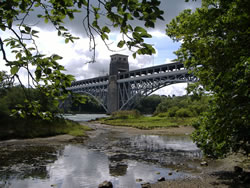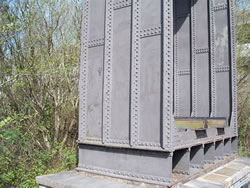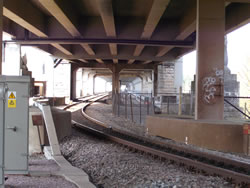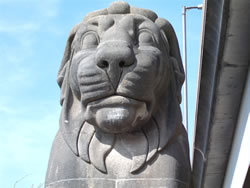The Britannia Bridge
"If your bridge succeeds, then mine have all been magnificent failures."
These were the words of Isambard Kingdom Brunel when he learnt of Robert Stephenson's plans to construct a tubular bridge across the Menai Straits. In part, Brunel's words reflected the fact that Thomas Telford had chosen the easiest point at which to cross the Straits when he built his Menai Suspension Bridge, which meant Stephenson was faced with span of 1,475 feet (461 metres), compared with Telford's more modest span of 1,007 feet (305 metres). But Brunel was also anxious about the innovative engineering that the project would entail, as Stephenson had opted for a tubular design. This meant the trains would run through the middle of the wrought iron tubes, rather than on top as would have been expected. In addition, Stephenson also had to meet the same Admiralty demands that faced Telford, that of a clear span of 100 feet (31 metres) above sea level.
The tubular bridge in fact comprised 8 separate tubes, 4 for the up-line, and 4 for the down-line, positioned between the land abutments, and the 3 new towers. The tubes were constructed in purpose built works on the banks of the Menai Straits, and the 4 largest ones were floated out on pontoons on a high tide. These pontoons were controlled by cables wound round mooring bollards located on the shore, and one of these is shown in the photograph above. The pontoons were then positioned between the new towers, and as the tide fell, the tubes came to rest on temporary supports at the foot of the towers. They were then raised carefully on hydraulic jacks, with masonry being laid beneath them as they were raised. The process took several months, with the Up-line being completed on 5 March 1850. The Down-line was completed and the bridge formally opened to two way traffic in October 1850.
The bridge was an engineering triumph, with concerns over thermal expansion dealt with by the provision of summer and winter rails at the bridge portals. The rails ran within the tubes on longitudinal timbers, and the bridge was covered internally with a canopy of tarred canvas. That arrangement was a long-standing success until outside intervention caused the loss of the bridge in 1970.
The Fire
On 23 May 1970, some children out on a hunt for birds' nests entered the tubular bridge, and lit paper to see their way in the dark. In doing so, they accidentally set fire to the canopy of tarred canvas. A major blaze then ensued, with the timber decking within the tubes providing plenty of combustible material. Although fire services were soon on the scene, there were difficulties in gaining access, and further difficulties in getting a sufficient supply of water. When the fire was eventually put out, the damage was such that the tubes were sagging between the towers, and structural integrity had been shattered.
The future for the bridge was settled within a matter of days, and there was no doubt that the bridge would have to be rebuilt. Apart from the fact that the bridge was a vital link in rail traffic between England and Ireland, a considerable amount of freight was now passing through Holyhead. Passenger numbers had also been increasing.
The reconstruction presented an opportunity to add a road deck and address the issue of increasing road in addition to rail traffic. The towers of the Britannia bridge had survived the fire and could be reused, but no part of the original tubular structure could be retained. The engineers opted to have a new deck for the rail traffic at the same level as the original, but with a new road deck carried on top. The whole structure would be supported on steel arches.
The rail structure was completed in January 1972. Although the deck contains sufficient width to accommodate two running lines, the decision was taken to have a single track, with two line working on either side of the bridge. The road deck was opened in 1980, more than 10 years after the fire. One consequence of the rebuilding is that the four Egyptian style lions, two on each side of the Menai Straits, are now hidden from view, unless you go down to rail level. These lions were the subject of a rather modest poem at the time of the bridge's opening in 1850.
Four fat lions,
Without any hair,
Two over this side,
And two over there.
Pedwar llew tew,
Heb ddim blew,
Dau'r ochor yma ,
A dau'r ochor drew.
However, notwithstanding the addition of a road deck, road demands have continued to increase, and engineers are again looking at how this may be addressed. Alternatives include a tunnel, a new bridge, and additional lanes fixed to the side of the existing bridge.






